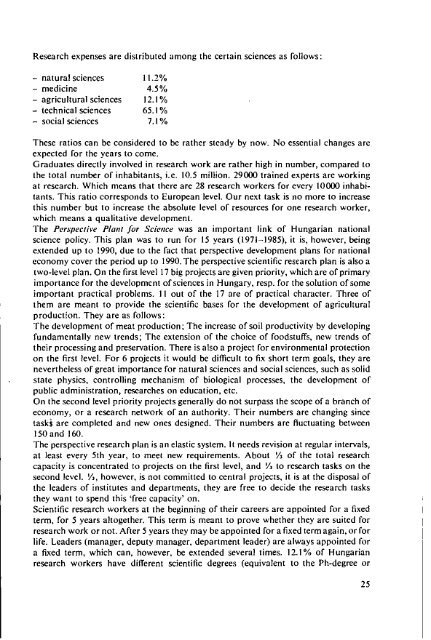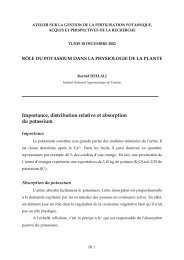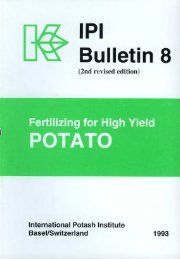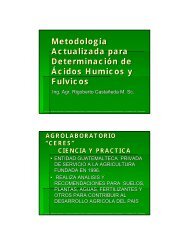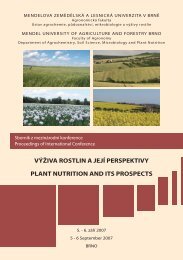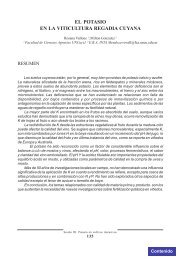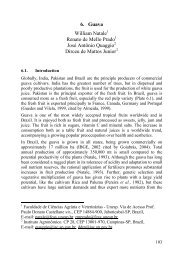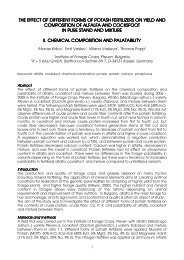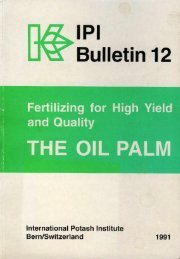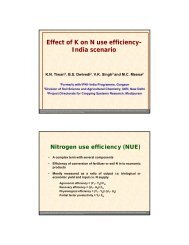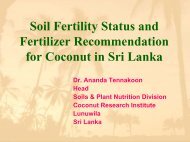Potassium Research and Agricultural Production - The International ...
Potassium Research and Agricultural Production - The International ...
Potassium Research and Agricultural Production - The International ...
Create successful ePaper yourself
Turn your PDF publications into a flip-book with our unique Google optimized e-Paper software.
<strong>Research</strong> expenses are distributed among the certain sciences as follows:<br />
- natural sciences<br />
- medicine<br />
- agricultural sciences<br />
technical sciences<br />
- social sciences<br />
11.1%<br />
4.5%<br />
12.1%<br />
65.1%<br />
7.1%<br />
<strong>The</strong>se ratios can be considered to be rather steady by now. No essential changes arc<br />
expected for the years to come.<br />
Graduates directly involved in research work are rather high in number, compared to<br />
the total number of inhabitants, i.e. 10.5 million. 29000 trained experts are working<br />
at research. Which means that there are 28 research workers for every 10000 inhabitants.<br />
This ratio corresponds to European level. Our next task is no more to increase<br />
this number but to increase the absolute level of resources for one research worker,<br />
which means a qualitative development.<br />
<strong>The</strong> Perspective Plant for Science was an important link of Hungarian national<br />
science policy. This plan was to run for 15 years (1971-1985), it is, however, being<br />
extended up to 1990, due to the fact that perspective development plans for national<br />
economy cover the period up to 1990. <strong>The</strong> perspective scientific research plan is also a<br />
two-level plan. On the first level 17 big projects are given priority, which are of primary<br />
importance for the development of sciences in Hungary, resp. for the solution of some<br />
important practical problems. 11 out of the 17 are of practical character. Three of<br />
them are meant to provide the scientific bases for the development of agricultural<br />
production. <strong>The</strong>y are as follows:<br />
<strong>The</strong> development of meat production: <strong>The</strong> increase of soil productivity by developing<br />
fundamentally new trends; <strong>The</strong> extension of the choice of foodstuffs, new trends of<br />
their processing <strong>and</strong> preservation. <strong>The</strong>re is also a project for environmental protection<br />
on the first level. For 6 projects it would be difficult to fix short term goals, they are<br />
nevertheless of great importance for natural sciences <strong>and</strong> social sciences, such as solid<br />
state physics, controlling mechanism of biological processes, the development of<br />
public administration, researches on education, etc.<br />
On the second level priority projects generally do not surpass the scope of a branch of<br />
economy, or a research network of an authority. <strong>The</strong>ir numbers are changing since<br />
tasks are completed <strong>and</strong> new ones designed. <strong>The</strong>ir numbers are fluctuating between<br />
150 <strong>and</strong> 160.<br />
<strong>The</strong> perspective research plan is an elastic system. It needs revision at regular intervals,<br />
at least every 5th year, to meet new requirements. About I!J of the total research<br />
capacity is concentrated to projects on the first level, <strong>and</strong> Ifl to research tasks on the<br />
second level. Ifl, however, is not committed to central projects, it is at the disposal of<br />
the leaders of institutes <strong>and</strong> departments, they are free to decide the research tasks<br />
they want to spend this 'free capacity' on.<br />
Scientific research workers at the beginning of their careers are appointed for a fixed<br />
term, for 5 years altogether. This term is meant to prove whether they are suited for<br />
research work or not. After.5 years they may be appointed for a fixed term again, or for<br />
life. Leaders (manager, deputy manager, department leader) are always appointed for<br />
a fixed term, which can, however, be extended several times. 12.1% of Hungarian<br />
research workers have different scientific degrees (equivalent to the Ph-degree or<br />
25


